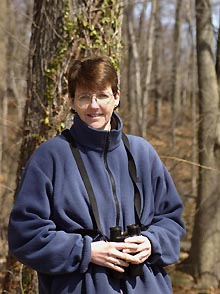|
This is an archived article.
For the latest news, go to the
Advance Homepage
For more archives, go to the Advance Archive/Search Page. | ||||
|
Ornithologist Sheds Light On Don't eat with your mouth open. Unless you're a bird, that is. For some birds, eating with an open mouth is one way nature takes advantage of the laws of physics, and their beaks have evolved to equip them to do precisely that, says Margaret Rubega. Rubega, an assistant professor of ecology and evolutionary biology who is also the state ornithologist, is conducting research on the evolution of feeding systems in birds and its relationship to the environment.
The question that drives her is: Why do birds have so many different kinds of beak? "In comparison with other kinds of vertebrates," she says, "they have such variable mouth parts." Mammals all have jaws, and they mostly have teeth, she notes. Yet there is enormous variation in the size, shape and structure of birds' beaks. Rubega's research focuses on how this variation influences birds' feeding performance. To answer this question, she makes detailed observations of how birds feed. Working with shore birds in the lab, she films them feeding at close range with high speed video equipment - about 250 frames a second. She then reviews the tape at half speed, to see which type of beak works best if you give different birds the same food under the same conditions. "You can't give both a pelican and a duck a fish, and expect them to eat it in the same way," she says. Rubega combines research in the lab with research in the field. Although keeping birds temporarily in captivity creates an artificial setting, she says her lab work enables her to get answers to her questions. "In the field, you can't control the factors that allow you to compare performance directly," she says. She does, however, compare her lab results with observations made in the field. Uphill Task The bird feeds on tiny invertebrates, grabbing them in the tip of its jaws. Water sticks to the prey and, because water molecules are attracted to each other, they form a droplet with the prey suspended inside. Because the water also adheres to the beak, the droplet is suspended between the bird's upper and lower jaw. When the bird opens its beak, the drop is stretched, its molecules pulled away from each other. Stretching the drop requires an investment of potential energy, like stretching a rubber band. Unless it is held in place, the drop moves in the direction where it can be as small as possible - in this case, to the back of the bird's beak. The drop actually runs uphill, without the bird's using suction. As the drop reaches the top of the beak, the bird pumps its tongue against the roof of its mouth so that the water in the droplet is pushed out and the bird swallows the prey. The entire process happens very fast, says Rubega, in small fractions of a second. Based on her observations, Rubega developed a model that accurately predicted which aspects of jaw structure in birds are important for performance. Journey of Discovery Her studies of the red-necked phalarope will likely take her to several different places. The bird spends part of the year out at sea in the Arctic, part in meltwater pools on the tundra, and part on lakes in the western United States. The water in each of these locations has a different level of salinity, and this affects the surface tension of the water - higher in fresh water, lower in salt water. Rubega hopes to find out how the bird's feeding performance varies in each of the three locations. She has already found out, however, that oil can have a devastating effect on birds' ability to feed using the surface tension mechanism. "If there's oil on their beaks, they can't feed at all," she says. "It's not just their feathers that are affected by an oil spill." Rubega's work is a prime example of how painstaking research at the micro-level lays the groundwork for addressing larger issues. "Feeding mechanisms translate up," she says. "If you want to conserve populations of animals, you have to understand their biology." Blown Away by Biology "I try to convey to students that the life they see around them is just the tail end of the dragon from an evolutionary point of view," she says. Three years ago, she introduced a two-credit lab course on ornithology as a companion to the existing ornithology lecture course. "I can't imagine teaching about birds without teaching outside," she says. "You don't need to see exotic birds to be blown away by how amazing their biology is." During the first lab class this semester, the temperature was just 10 degrees. Rubega took her 15 students for a walk behind the dorms to observe sparrows and talk about thermo-regulation in birds: "The students were complaining, yet they were wearing Goretex, Polar Fleece, and down. These birds had spent the night at 5 below zero." Rubega explained that birds have to eat all day long to maintain their body temperature. They pick microclimates that help them with their metabolism and roost in the most sheltered places they can find. "In a hard winter like this one," she says, "a lot of birds don't make it." |


